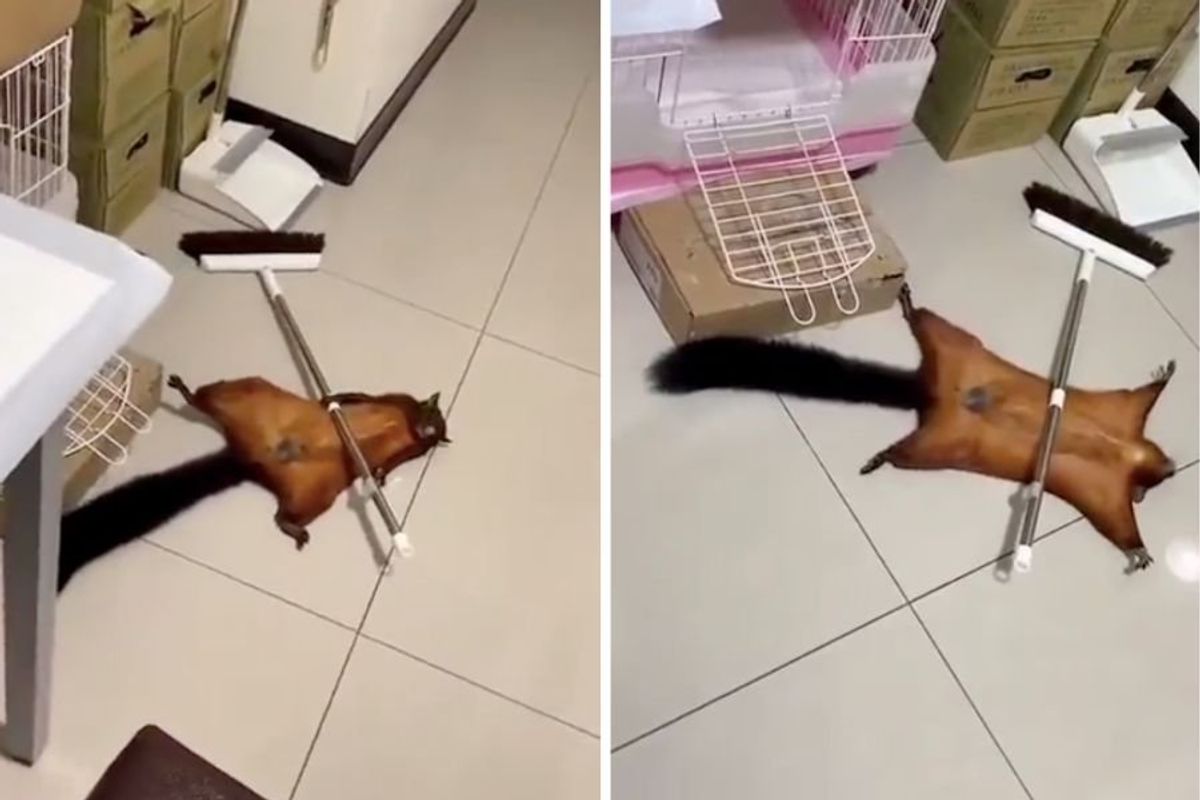Flying squirrel repeatedly fakes its own death with a broom handle and people are losing it
And the Oscar goes to…

Dramatic flying squirrel makes it look like the broom fell on it. Spoiler: It did not.
Animals can be far cleverer than we give them credit for, especially creatures we don't think of as having distinct personalities. Most of us expect cats and dogs to do show us their unique quirks, but what about a flying squirrel?
A video is making its way around the internet that has people giggling over the dramatic antics of a large pet flying squirrel. It includes no narration explaining what's happening and no context—it just shows a flying squirrel repeatedly faking its own death by broom.
That's right. Death by broom. And from the way it looks, the little bugger came up with the idea on its own and made multiple attempts to create a convincing crime scene.
This is one you just have to see.
Twitter user @Birrellebee wrote that the squirrel "faked his own death, and created a whole crime scene…for attention. I think I'm in love."
Whether the squirrel really did this just for attention or for some other reason isn't clear, but no one seems to offering a more plausible explanation for it.
Watch:
\u201cThis flying squirrel faked his own death, and created a whole crime scene\u2026for attention. I think I\u2019m in love. \u201d— Sarah Bee\ud83d\udc1d (@Sarah Bee\ud83d\udc1d) 1685808791
While some people have expressed understandable concern over flying squirrels living indoors as pets, we don't know what the living situation here really is. Maybe the squirrel was injured and rescued. Maybe it can't survive in the wild. We simply don't know.
What we do know is that this adorable rodent deserves an Oscar for its performance. The way it gracefully somersaults right into position. The placing of the broomstick on its neck and splaying itself out flat on its back. The checking to see if anyone is looking. The repositioning of the murder weapon multiple times to figure out which one seems more believable.
Was that really what it was doing? Who knows. But it was a genuinely incredible performance nonetheless.
And of course, the people of the internet didn't disappoint in the comments.
\u201c@pimlius @nycsouthpaw Well, maybe he should\u2019ve thought of that, befor being such a wee drama queen. Nobody likes an attention whore.\u201d— Sarah Bee\ud83d\udc1d (@Sarah Bee\ud83d\udc1d) 1685808791
\u201c@RIDICULO_pathy @BirrelleBee I love this squirrel \ud83d\ude02\ud83e\udd70\u201d— Sarah Bee\ud83d\udc1d (@Sarah Bee\ud83d\udc1d) 1685808791
“@GreigBeck @BirrelleBee @MAllanScott It’s an insurance scam.”
\u201c@GreigBeck @BirrelleBee @MAllanScott It\u2019s an insurance scam.\u201d— Sarah Bee\ud83d\udc1d (@Sarah Bee\ud83d\udc1d) 1685808791
\u201c@Marx_Bros_Thing @BirrelleBee Same\u201d— Sarah Bee\ud83d\udc1d (@Sarah Bee\ud83d\udc1d) 1685808791
This article originally appeared on 6.6.23
- Incredible 'bird feeder' photos give a whole new perspective on our feathered friends ›
- Man captures magical scenes of acorn characters and the wildlife that stumbles upon them ›
- 15 of the best entries in the 2022 Comedy Wildlife Photography Awards contest ›
- People share the quirkiest things their pets do - Upworthy ›
- 15 things people 'pretend' to like - Upworthy ›












 The more passionate you are about your goals, the more secretive you should be.
The more passionate you are about your goals, the more secretive you should be.  Potted plants and herbs can thrive in a container garden.
Potted plants and herbs can thrive in a container garden. Freshly harvested potatoes are so satisfying.
Freshly harvested potatoes are so satisfying. Do you see a box or do you see a planter?
Do you see a box or do you see a planter? Kamikatusu's recycling techniques are well worth the effort.
Kamikatusu's recycling techniques are well worth the effort.  The inside of Kamikatsu's Zero Waste Center.
The inside of Kamikatsu's Zero Waste Center.  How to recycle boxes and other cardboard goods.
How to recycle boxes and other cardboard goods.  Give radical recycling a try.
Give radical recycling a try.  Raise that top dishwasher rack to the roof!
Photo by
Raise that top dishwasher rack to the roof!
Photo by  How it feels to learn you've been using your dishwasher wrong for yaers.
How it feels to learn you've been using your dishwasher wrong for yaers.